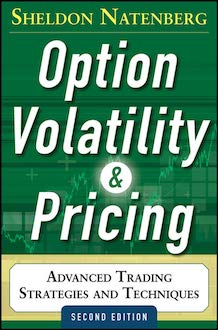 I’ve been studying and trading options for the past several months. It’s not a style drift, but adding an uncorrelated income stream to the current systematic portfolio of stocks and futures. I have already read several blogs and papers about options, listened to over a hundred podcast episodes, backtested my own ideas and I’m currently trading short-term index options on SPX, also known as 0DTE weekly options (SPXW). I got this comprehensive book about options pricing and took notes while slowly studying it. I’m going to share my findings here in this review. The book was first published already back in 1988, but this is the second edition published in 2015.
I’ve been studying and trading options for the past several months. It’s not a style drift, but adding an uncorrelated income stream to the current systematic portfolio of stocks and futures. I have already read several blogs and papers about options, listened to over a hundred podcast episodes, backtested my own ideas and I’m currently trading short-term index options on SPX, also known as 0DTE weekly options (SPXW). I got this comprehensive book about options pricing and took notes while slowly studying it. I’m going to share my findings here in this review. The book was first published already back in 1988, but this is the second edition published in 2015.
I took some notes for myself that I can visually understand well when looking at the option chain in a trading software, but it’s often a good exercise to write things down:
1. Call option’s intrinsic value equals stock price subtracted by strike price, and put option’s intrinsic value equals strike price subtracted by stock price.
2. An option has intrinsic value if it’s in the money (ITM). An out-of-the-money (OTM) option has no intrinsic value, but only time value. Therefore, the intrinsic value of an option can’t be negative.
3. If the call option of a stock is ITM, the put option with the same strike of the stock can only be OTM, and vice versa.
4. If the strike price is equal to stock price, the option is at-the-money (ATM). These options are usually traded the most at the time.
5. The option’s trading price is the sum of intrinsic and time value, so the time value can be calculated by subtracting the intrinsic value from option’s price.
6. At the expiration, an option is worth only its intrinsic value, either zero if it’s OTM or the difference between the exercise price and underlying price if it’s ITM.
7. The option’s buyer has limited risk by the price paid, with unlimited potential gain; the option’s seller has unlimited potential risk, with limited gain by credit received. That being said, a put option has limited gain and limited risk in theory, because the price of a stock can’t fall below zero, but let’s stick to the practical side of buying and selling options in the context of trading, where one doesn’t wait for the stock to go to zero.
8. The most used Black-Scholes options pricing model looks at five characteristics: strike price, time remaining, current stock price, interest rate, volatility.
9. By knowing the strike price, stock price, interest rate, time to expiration and the current option price, we can then calculate the implied volatility that the market is considering at this moment.
10. Realized vol is calculated from price changes of the underlying asset, implied vol is based on the option price itself.
11. Change in volatility affects more further OTM options and more long-term options over short-term ones.
Some additional points I’ve studied about trading options that are important to understand:
– When trading options, always check the contract’s settlement conditions if it allows early assignment or only at the expiration (US vs European); if it’s cash or stock settled; and if it’s AM or PM settled meaning there could be a chance of overnight gap risk without being able to trade the position!
– Risk-first approach! Options are a highly leveraged instrument, therefore always check the notional value of a position and how much possible risk it introduces.
– Just like with trading stocks, options trading also comes with risk and reward hand in hand. Small wins are usually high probability trades while expecting large wins means generally low probability trades.
– When stock trading is associated with the direction of the market, then options trading also considers the speed of the move, meaning a trader needs to look at time and volatility.
– VIX is the volatility index from CBOE. It uses SPX weekly and monthly options of 23-37 days to expiration that expire on Fridays, to calculate the expected volatility of S&P 500 index for the following 30 days.
The book has a lot of content tied to options and futures, so it is a longer read to digest all the information. There’s more about interest rates, dividends and volatility in options pricing, standard deviation from the mean, probabilities of a +/- 1-3 standard deviation moves, normal distribution under low vol and high vol. The author explains risk management and topics about risk / reward.
I now understand even better the Greeks (delta, gamma, theta, vega and rho), but there’s also charm and vanna – measures of a measurement (delta). The book consists a lot of graphs and illustrations to better explain all the material and math about options. The author writes about strategies like strangle, straddle, condor, butterfly, spreads and others.
I’ve pointed out things that were important to me at the time of reading, something different might catch your attention based on the style of trading. Therefore, if wanting to understand volatility and options pricing, I definitely recommend to read and study the whole book. Either this book or another similar one, the theory of options pricing is a must read if you want to take options trading seriously.
Option Volatility and Pricing by Sheldon Natenberg book link
Share this post